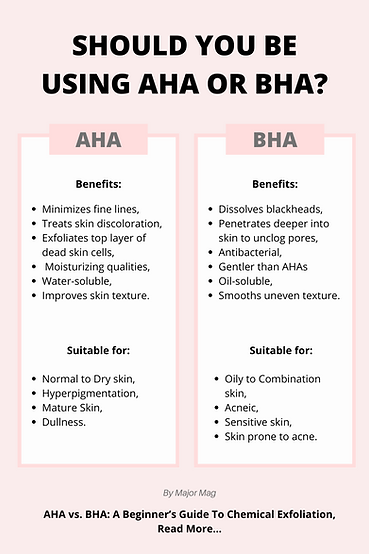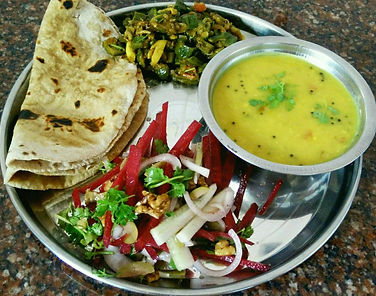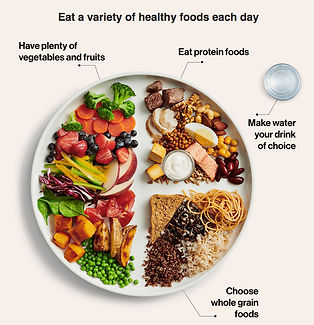Your A-Z guide for chemical exfoliants and what you should use according to your skin concern...
The skin cells in our body typically regenerates on their own every month approximately, however our lifestyle, stress, harmful UV rays from the Sun, pollutants in our surroundings and skin ageing can all steal our natural glow, slow down the process and contribute to several skin concerns. This is where exfoliation comes into picture.
It’s a quick and easy way to remove your dead skin cells, brighten up your skin and even help remove acne marks, hyperpigmentation and early signs of ageing.
Now we are all aware of over the counter physical exfoliants available in the market, like scrubs, peels and masks. However, these physical exfoliants could be too harsh for some of us, specially those having sensitive skin and can do even more harm than good.
On the contrary, chemical exfoliants are basically serums consisting a range of different acids which are milder to the skin. These seem to have gained an increase in popularity in the recent years.
But the majority skincare community is still unaware or is confused about what chemical exfoliants actually are, and how we can use them in our daily skincare to promote a radiant and spotless skin. Here’s what you need to know:
Chemical exfoliants are acids that comes in a variety of concentrations, single or combined.
These make their formulas weaker and stronger, depending upon the concentration. While weaker formulas are readily available over the counter, stronger ones require your dermatologist’s approval and super vision.
They promote skin regeneration by breaking the bonds that holds skin cells together, says board-certified plastic surgeon Dr. Michelle Lee.
“As those bonds are broken, the top layers of the skin cells shed, revealing regenerated skin,” she says.
With continued use, skin feels softer, better, devoid of dead skin cells, and looks more even toned, pores unclogged, fading away signs of ageing.
Both physical and chemical exfoliants share the shame role- that is, to remove the upper dead layer of the skin. While chemical exfoliants do that in an effortless manner, physical ones do it manually and also doesn’t penetrate as deeply as the acids present in the chemical exfoliants, making them less effective.
It is also advisable not to use physical exfoliants like scrubs, brushes more than twice a week, for the obvious reason that they could be harsh on the skin, while the mild acids present in the chemical exfoliants could be used on a daily basis and even twice a day in our skincare regime.
If followed religiously, they can transform your skin and do wonders to it because of their penetrating and working on the root cause properties.
So, I would choose them any day over the other options available.
Chemical exfoliants comes in two major types. All are acids, differed by their concentration and penetrative properties. They come in a variety of forms like cleansers, toners, moisturizers, scrubs, peels, and masks.
Main thing to Remember: The higher the concentration and lower the pH, the more intense the exfoliative effect.
1.Alpha Hydroxy Acids (AHAs)
AHAs are a group of plant and animal-derived acids, most commonly used in skincare products like serums, toners, and creams, etc.
AHAs include:
-
glycolic acid (from sugar cane)
-
citric acid (from citrus fruits)
-
hydroxycaproic acid (from royal jelly)
-
hydroxycaprylic acid (from animals)
-
lactic acid (from lactose or other carbohydrates)
-
malic acid (from fruits)
-
tartaric acid (from grapes)
Out of all the AHA(s), glycolic acid and lactic acids are the most promising and widely used in over the counter (OTC) products. They are also very mild to the skin and cause less to no irritation.
Apart from their primary action of exfoliating, they also:
-
promote blood flow and act as collagen booster
-
prevent acne formation/breakouts
-
lighten up complexion
-
correct discoloration from marks and age spots
-
improve visibility of fine lines and wrinkles
-
increase product absorption
2. Beta Hydroxy Acids (BHAs)
BHAs are oil-soluble acids, unlike AHAs which are water-soluble. They work on skin’s surface as well as open clogged pores, thereby removing acne forming oil known as sebum.
Because of these effects, BHAs are most suitable for combination to oily skin.
Although BHAs don’t make your skin as sensitive to the sun compared to AHAs, you should still wear sunscreen every single day. This will help prevent further sun damage.
The most common form of BHA is:
Salicylic acid: The concentration can range anywhere between 0.5% to 5% depending on the product handy, and also the skin needs. If you’re someone who has decent skin with fewer blackheads and whiteheads here and there, you should go for lesser concentration, however if you’re someone who deals with a lot of acne, you must use a higher concentration on a regular basis.
We hope that this clears your doubts on the formulation and usage.
PRO TIP
If you’re primarily looking for dry skin relief or anti-aging benefits, try an AHA. If you want to tackle acne, look to BHAs.
WHAT YOU SHOULD USE IF YOU HAVE:
DRY SKIN-------------------------------- AHA
SENSITIVE SKIN--------------------- BHA
OILY/ACNE PRONE SKIN----------- BHA
COMBINATION SKIN----------------- AHA + BHA
MATURE SKIN------------------------- AHA
PIGMENTATION/DARK SPOTS--- AHA + BHA
SUN DAMAGE------------------------- AHA
WHITEHEADS/ BLACKHEADS--- BHA
OUR RECOMMENDATIONS:
-
Derma Co’s 2% Salicylic acid
-
Paula’s Choice 2% BHA Liquid Exfoliant
-
Derma Co’s 15% AHA+ 1% BHA Beginner Peeling Face Solution (for beginners)
-
Minimalist AHA 25% + 2% BHA Peeling Solution (for advanced)
-
The Ordinary AHA and BHA Peeling Solution
-
Dot and Key hydro peel glow potion 10% AHA + 2% BHA exfoliating serum
-
Pixi glow tonic
-
O3+ skin care micro derma brasion facial peel
-
Dr Sheth’s basic brightening extra gentle daily peel
You can also try out different range from these brands and stick to what suits best for your skin.
Things to Remember:
-
Whichever acid you decide to use, start off slowly. Try applying once a week to see how your skin reacts, increasing to two or three times a week if no irritation occurs.
-
There are two things you need to remember post-exfoliation: moisturizer and sun protection.
-
Chemical exfoliants do have the potential to leave skin feeling dry. To combat this, moisturize well immediately afterward.
-
You’ll also need to apply SPF as AHAs and BHAs can make skin more sensitive to the sun.
In fact, if you’re planning on spending a day in the sun, it’s best to apply an exfoliating acid at night. How to combine AHA and BHA products
According to a study, AHAs and BHAs yield fuller skin when used together. This may be due to increased collagen production, which can make both the dermis and epidermis visibly plumper.
Because of this, many occasional-use products, such as Minimalist AHA 25% + 2% BHA Peeling Solution, contain both acids.
Still, you don’t want to layer AHAs and BHAs on top of one another. These are both exfoliators, so using both can cause dryness and irritation.
PRO TIP
You can alternate products by using one type in the morning and the other during your nighttime routine.
You could also use AHAs and BHAs on alternating days. This method works well if you’re using at-home chemical peels that contain AHA.
Another strategy is to use these acids on certain parts of your face only. For example, you can apply an AHA to dry areas and a BHA to oily areas if you have combination skin.
THE BOTTOM LINE
AHAs and BHAs share similar benefits. You can obtain some level of exfoliation from each one.
However, each ingredient can be used to achieve different skin care goals. If you’re looking for an all-inclusive anti-aging treatment, then an AHA may be the best fit. A BHA may better suited if you want to calm down inflammation and get rid of acne.
If you still aren’t sure which to choose, talk to your dermatologist. They can answer any questions you have and recommend specific ingredients or products to try.
No, you don't have to crash diet or eat less to lose weight. All you have to do is...
Yes, you read it right! If I were to tell you that you do not need to flow those old conventional strict diet plans and spend hours at the gym to lose weight, would you believe it? You wouldn't, right?
Gone are the times when the internet was flooded with compelling yet hard to follow information around weight loss and diet. The recent era demands effortless, flexible, and quick results around the corner.
Thanks to the pandemic, its onset brought about so many other health issues, apart from the mainstream virus, majorly because of a huge shift in our lifestyles, work approach, sleeping patterns and eating habits.. all because of staying at home 24*7. From working, to eating and sleeping, our beds had become one of those clingy best friends in every group, not wanting to leave their side anytime.
This pave the way to obesity, loss of stamina in adults, and even in children. Women, on the other hand developed hormonal imbalance issues and rise in lifestyle disorders like Policystic Ovarian Syndrome (PCOS) and thyroid was observed. This called for a greater need and attention to take care of our health, even while working from home and staying in all the time.
So here are 10 ways to lose weight without starving yourself or hitting the gym. You will be pleased to know that all of them are backed by science.
People, start taking notes-
1. Eat right. Know what you're eating
Be mindful about what you are consuming. Those ready to made and so called healthy soups and cornflakes are not at all healthy since they are packed with preservatives, to keep them fresh and edible for long. The best way to have soups is to freshly prepare them at home minus the cornflour.
In addition to this, you also need to avoid all those refrigerated snacks like fries which are ready within two minutes of deep frying and basically everything that's pre-cooked or half-cooked and promises to be made in such a short span.
Eliminate sugar, refined flour and refined oils completely from your grocery list. They come as weight clutter in our lives, without notice.
While refined oils have a direct proportionate rate with increasing heart diseases, sugar is the worst enemy for your skin since it promotes faster ageing and maida, needless to say, promotes obesity and other serious issues in our body.
2. Home cooked meals are your savior
Yes, freshly home cooked meals are what you should be having while trying to lose weight. Prepare garden-fresh, raw vegetables and try to add them to your meals at twice a day. Have your regular pulses, beans and lentils at least once in a day. Stick to your whole wheat or multi-grain chapati (2-3 in a day). You can also have white rice while trying to lose weight. Just make sure that you're combining it with pulses or veggies. Your perfect weight loss plate should look a lot like this. Chapatis for source of carbohydrates, pulses/lentils for source of protein and veggies as source of vitamins & fiber.
3. Make Fruits and Salads your Best Friend
Fruits are an excellent source of essential nutrients and are packed with health promoting oxidants. Fruits are also highly rich in fiber and eating a diet rich in high fiber can not only boost your gut health, but also aid the weight loss mechanism. As yummy as they may taste, they have even better health benefits by reducing a person's risk of various health diseases. Make it a daily habit to indulge in one seasonal fruit per day after having a good breakfast. You can even opt for a mix fruit chat as your breakfast option.
Salads should be your really go-to option when that hunger pank hits you in the middle of the day or in the evening and you're about to give up on your diet.
Whoever thinks that salads are boring, really didn't have or learn to make a better one yet. Salads can be so delicious and fulfilling at the same time.
Have a basic plate cucumber, raddish and carrot salad half an hour before your lunch. To make this interesting, you can give it a Greek touch by adding lemon, seasoning olive oil, and a little more veggies like lettuce, tomato, bell peppers, and olives, etc. This will sure shot make you a salad fan.
4. Have a balanced diet
I remember being taught this so much in school in so many of our science classes, that we should be having a balanced diet. But I believe we were too young and naive to understand it then and realize its meaning and importance, now rather. A balanced diet ensures that all our bodies' functions are governed properly and systematically. Now, in order to lose fat from our body, a balanced diet or meal should be looking a lot like this:
It should consist of as much grams of protein as you weigh from a rich plant or animal source (pulses, lentils, beans, eggs, meats, etc.); plenty of vegetables and good fats along with carbohydrates to curb your hunger.
5. Control your portion size
It doesn't matter what you're eating if you're overdoing it. Please make sure that you're keeping a check on the portion size of your meals or even the handful of snacks that you do consider healthy, holds an immense amount of calories within it. This can be achieved by using smaller plates. Now, you must be wondering whether this will left your stomach half filled or something. Don't worry, we have got you covered. The key is to have frequent meals within 1.5-2 hours of gap in between. This will ensure that you do not starve as well as do not not overeat your main meals. You can have a fruit, a handful of makhanas, a bowl of salad or soup within some intervals to keep your belly satisfied. You can apply the same techniques to your favorite meals or cheat meals.
6. Be in a calorie deficit
What most people don't understand while trying to lose weight- is to be in a calorie deficit diet. Now, when we say calorie deficit, we don't mean you to count calories in all of your meals. This will left you in even more stress and will not give you a great feeling about having food.
How do you calculate a calorie deficit? Your calorie deficit is the energy your body requires to maintain your current weight, minus your dietary calorie intake. So for example, if your body requires 2,000 calories a day and you only feed it 1,200 calories a day, you are in a 800 calorie deficit.
To lose weight, you need to eat and drink fewer calories than you burn. That's called a calorie deficit. If you take in more than calories than you burn, then you don't have a calorie deficit and you won't lose weight.
7. Exercise
It is a widely known concept that 70% of diet and 30% of exercise is all you need to shred those extra kilos off your body. So, please make sure that you're doing your bit. You do not have to get into rigorous and long hours of workout. It rather increases your cortisol levels which causes even more harm than good for females struggling with hormonal imbalances. 30 minutes of walk a day is considered to be a decent form of exercise while trying to lose and maintain a healthy weight. However, if you're willing to go an extra mile for your health, you can also strength train for 3-4 days a week for about 20-25 minutes, cycle, swim, run or even do yoga practice.
8. N.E.A.T
What is N.E.A.T? Have your ever heard of this term before in weight loss topics? No, right. Let's get you introduced to this one.
Non-exercise activity thermogenesis, or N.E.A.T., is a fancy name to describe the calories burned from all of the movement you do during the day apart from exercising, and to your surprise, it can make a big difference in your fat loss program. Examples of N.E.A.T are cooking, shopping, walking, gardening and hell no, even standing. So, people, take that extra mile, ditch the escalators and call your bff right away to get set going for a shopping spree.
9. Water Rule
.Who drinks water? The Queen of England does. So does three-time NBA champion LeBron James. Even Facebook CEO Mark Zuckerberg drinks water. In fact, just about everybody across the world drinks the life-giving beverage. But are you drinking enough? We cannot imagine our lives without water, but we seem to take it for granted like all the other good things in our lives Doctors recommend that you drink 3 liters of water a day in order to stay hydrated and to perform at your best. Also, ladies, to have that glow.
But who knew that water could also help in weight loss? Water can curb your appetite and since it devoid of calories, it can help you reduce calorie intake. Drinking 500 ml of water before each meal is a great way to do so. Oftentimes, when people think they are hungry, they are actually simply dehydrated.
10. Lastly, have patience
Nothing happens overnight. You did not gain all of your weight overnight, and so with the loss. You just have to be consistent, pertain to everyday mindful actions and choices, and try to inbuilt these practices into your lifestyle. That way, it won't feel like you're restricting yourself from something. Moreover, all these healthy habits can transform your lives in a long run. So, people, put over your headphones, turn on that music and get set going for that motivation run or a walk, maybe!?


